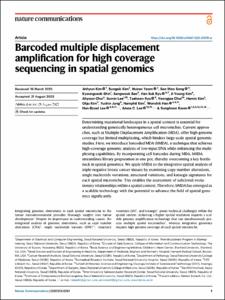GIST Scholar
College of Engineering
Department of Materials Science and Engineering
1. Journal Articles
Barcoded multiple displacement amplification for high coverage sequencing in spatial genomics
- Type
- Article
- Citation
- NATURE COMMUNICATIONS, v.14, no.1
- Issued Date
- 2023-08
- Abstract
- Determining mutational landscapes in a spatial context is essential for understanding genetically heterogeneous cell microniches. Current approaches, such as Multiple Displacement Amplification (MDA), offer high genome coverage but limited multiplexing, which hinders large-scale spatial genomic studies. Here, we introduce barcoded MDA (bMDA), a technique that achieves high-coverage genomic analysis of low-input DNA while enhancing the multiplexing capabilities. By incorporating cell barcodes during MDA, bMDA streamlines library preparation in one pot, thereby overcoming a key bottleneck in spatial genomics. We apply bMDA to the integrative spatial analysis of triple-negative breast cancer tissues by examining copy number alterations, single nucleotide variations, structural variations, and kataegis signatures for each spatial microniche. This enables the assessment of subclonal evolutionary relationships within a spatial context. Therefore, bMDA has emerged as a scalable technology with the potential to advance the field of spatial genomics significantly.
- Publisher
- NATURE PORTFOLIO
- Appears in Collections:
- Department of Materials Science and Engineering > 1. Journal Articles
Items in Repository are protected by copyright, with all rights reserved, unless otherwise indicated.
